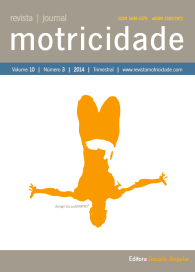Contribution of different body segments in Sit and Reach Test
DOI:
https://doi.org/10.6063/motricidade.6006Resumo
This research aims to determine the contributions of the hip joint, lumbar and thoracic spine in the execution of Sit and Reach (SR) in young Brazilians. Subjects were 195 boys from 18 to 19 years., Sit and Reach was evaluated with angular kinematic analysis through of Photogrammetry to identify the contribution of body segments in trunk flexion. A protocol was developed for evaluating reference angles that were transformed into percentage contribution of the segments. Based on the results, it was possible to create a table of classification of angles and percentages, which allowed the identification of compensation movement. It was possible to conclude that the contributions of the thoracic spine, lumbar spine and hip in performing the SR are 46.01±7.32%, 12.68±5.12% and 41.31±7.19% respectively. It is recommended that evaluations of flexion of the hip joint, thoracic and lumbar spine are performed separately by photogrammetry.
Downloads
Ficheiros Adicionais
Publicado
Edição
Secção
Licença
Os autores dos manuscritos submetidos para publicação deverão ceder, a título integral e permanente, os direitos de autor (copyright) à revista Motricidade e às Edições Sílabas Didáticas. A cedência de direitos de autor permite a publicação e divulgação do artigo em formato impresso ou eletrónico e entrará em vigor a partir da data de aceitação do manuscrito. Os autores concedem, ainda, os direitos para a revista Motricidade utilizar e explorar o respetivo artigo, nomeadamente para licenciar, ceder ou vender o seu conteúdo a bases de resumos/indexação ou outras entidades.
Nos termos da licença “Creative Commons”, os autores poderão reproduzir um número razoável de exemplares para uso pessoal ou profissional, mas sem fins comerciais. Nos termos da licença SHERPA/RoMEO, os autores poderão, ainda, disponibilizar/arquivar uma cópia digital final (versão postprint) do artigo no seu website ou no repositório científico da sua instituição.


